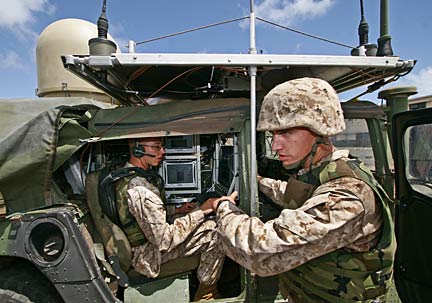
|
Marines praise
data relay
A communications vehicle
being tested here has applications
for natural disasters
Marine Corps and local high-tech officials say a front-line communications vehicle being tested in the islands could have provided badly needed communications links during the crucial moments after Hurricane Katrina hit the Gulf Coast.
Col. Steven Hummer, who became the newest commander of Marine Corps Base Hawaii on Friday, last week told reporters the portable communications developed and being tested at Kaneohe Bay are "so light -- they could have been flown in quite easily. They could have been set up in various locations.
"The system could exchange maps that would show where various things were," Hummer said. "Operational graphics would be on those maps and then the commanders could make the right decision at the right times to help any situation."
With cell phone towers down and no electricity in many of the Gulf states after the hurricane, there were reports that that some military units had to send soldiers by foot with handwritten notes to command posts, said David Ushio, who heads what he hopes will be a multimillion-dollar communications venture for the islands.
"It was a situation that prompted observers to liken the situation to the Civil War," said Ushio, president of Pacific Technologies.
Pacific Technologies and 10 other firms, several of them based in the islands, for the past 12 months have been developing a mobile satellite, radio, video and data communications which the Marine Corps says it needs so its commanders can maintain the full picture of the battlefield.
Island-based companies Oceanit and Akimeka worked on the antennas while Referentia helped with the network management software.
Shujie Chang, director of the Marine Forces Pacific experimentation center, said the communications system now being tested will "fill the current gap for wideband satellite communications" that are urgently needed by the Marines since they are generally the first troops into a combat zone.
Labeled as the mobile modular command and control, or M2C2, the vehicle is equipped with radios, communication computers and satellite links and allows the Marines to set up communications while on the move.
"That is something we can't do today," said Cpl. Jayson Schemenauer, a 22-year-old data operations specialists.
"Half of the equipment in my Humvee is off the shelf, and the other half is Marine communications equipment we already use," said Schemenauer.
What is unique about the M2C2 vehicle is that it could replace what the Marines now haul into the battlefield in three Humvees and three trailers powered by a field generator.
Hummer said, "M2C2 can be put into any vehicle. It is self-contained."
While stationed in Iraq, Hummer's troops had to stop periodically, set up satellite communications antennas, and log on to download e-mail and make tactical telephone calls. The new technology would allow Marines to do all of the above while moving.
Maj. Richard Bordonara, 3rd Marine Regiment's communications officer, said even as the Marines moved the M2C2 Hummer to Bellows Air Force Station last week "its operators could surf the Internet while driving down the highway and could even make commercial phone calls."
Ushio said $5 million for the project, which was initiated by the Marine Corps leaders at Camp Smith more than four years ago, was secured by U.S. Sen. Daniel Inouye through the Office of Naval Research.
"We're in the process of getting another $5 million," Ushio added. In addition, there is up to $20 million in funds being considered by Congress as part of the military budget for the next fiscal year.
Ushio said it took 12 months to develop two prototypes using Humvees from the Marines at Kaneohe Bay.
"The cost of production has not been established," Ushio added, "but estimates range at just over $1 million per M2C2."
Ushio acknowledged one problem that still needs to be addressed is reducing the configuration of the large three-foot dome, which looks like a Marine Corps version of a "Star Wars" R2D2 robot, and which houses the unit's satellite antenna.
"That's like painting a big bulls-eye on the Humvee and makes it stand out," Ushio added.
The computers on the M2C2 also has a chat program where units in the field can text messages to their commander as was demonstrated on Thursday. Another computer program tracks every vehicle in a unit and has the ability to transmit live time video from the field to any command center.
Ushio estimates that once the project is given its final approval from the Marines, the first communications vehicle could be fielded in 18 months and would add to the $500 million the Marine Corps Base Hawaii pumps annually into the Hawaiian economy.
The prototypes will be flown to Twenty-nine Palms Marine Corps Base in southern California and will undergo more field testing in early October.
www.mcbh.usmc.mil
E-mail to City Desk
[News] [Business] [Features] [Sports] [Editorial] [Do It Electric!]
[Classified Ads] [Search] [Subscribe] [Info] [Letter to Editor]
[Feedback]
